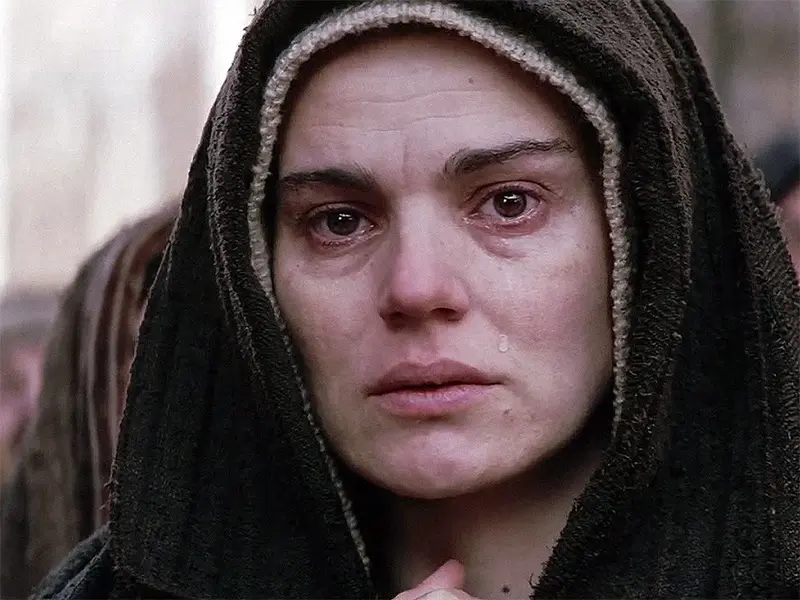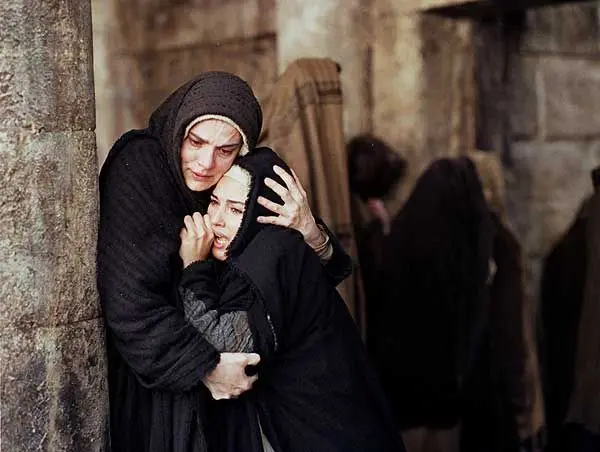
In the portico at the entrance to the Easterthe Friday of Sorrows marks a profoundly spiritual anteroom that invites us to contemplate the silent and loving suffering of our mother, our mother, the Virgin Mary. This day, celebrated on the Friday before Palm Sunday, becomes an opportunity to approach the heart of a mother who accompanies the way of the cross of her Son. In many parishes the Way of the Cross is replaced by the Via Matrix that contemplates the sufferings of Mary.
The so-called Seven Sorrows of the Virgin Mary are a centuries-old devotion that invites to meditate on the most painful moments that Mary lived with Jesus. Through this meditation, the faithful find a bridge to connect their own suffering with Christian hope.

When Mary presents Jesus in the temple, Simeon announces to her that a "sword will pierce his soul". This first sorrow opens Mary's heart to an uncertain future, full of trials where everything in her is Faith and Hope in her Son as she did in her first great yes in the Incarnation.
Teacher of charity. Remember that scene of the presentation of Jesus in the temple. The old man Simeon "assured Mary, his Mother: "Behold, this child is destined for the ruin and resurrection of many in Israel and to be the target of contradiction, which will be for you a sword that will pierce your own soul, so that the thoughts hidden in the hearts of many will be revealed". Mary's immense charity for humanity makes Christ's affirmation true also in her: "Greater love has no one than this, that a man lay down his life for his friends".
In the midst of Holy Week, this passage reminds us that faith does not always mean certainty, but trust in the midst of darkness.
Mary and Joseph must flee to Egypt to protect the child Jesus from the threat of Herod. This scene speaks to us of the pain of instability, of abandoning one's own land and of fear for the life of a child. The Virgin Mary becomes the image of all mothers who must leave everything for love.
After he had departed, an angel of the Lord appeared to Joseph in a dream and said, "Arise, take the child and his mother and flee to Egypt; stay there until I tell you, for Herod is going to seek the child to destroy him." He arose, took the child and his mother by night and went to Egypt. There he stayed until the death of Herod, so that what the Lord announced by the prophet would be fulfilled when he said, "Out of Egypt I called my son" (Mt 2:13-15).
Mary cooperated with her charity so that the faithful could be born in the Church, members of that Head of which she is effectively mother according to the body. As Mother, she teaches; and, also as Mother, her lessons are not noisy. It is necessary to have in the soul a base of refinement, a touch of delicacy, in order to understand what she manifests to us, more than with promises, with works.
For three days, Mary and Joseph search for Jesus, who had remained in the temple. The anguish of loss and helplessness in the face of what is not understood are human emotions that we have all experienced. The Virgin Mary takes them on with faith and humility.
The Gospel of the Holy Mass reminded us of that moving scene of Jesus, who remains in Jerusalem teaching in the temple. Mary and Joseph went the whole journey, asking relatives and acquaintances. But when they did not find him, they returned to Jerusalem in search of him. "The Mother of God, who eagerly sought her son, lost through no fault of hers, who experienced the greatest joy in finding him, will help us to retrace our steps, to rectify what is necessary when, because of our lightness or sins, we fail to distinguish Christ. We will thus attain the joy of embracing Him again, to tell Him that we will not lose Him any more (Friends of God, 278).

On the Via Dolorosa, Mary meets her Son carrying the cross. She cannot stop the suffering, but she is there. This scene, so representative in Holy Week processions, speaks to us of the value of presence, of being with the suffering even if we cannot change their destiny.
Hardly has Jesus risen from his first fall, when he meets his Blessed Mother, beside the road through which he is passing.
With immense love Mary looks at Jesus, and Jesus looks at his Mother; their eyes meet, and each heart pours into the other its own sorrow. Mary's soul is flooded with bitterness, in the bitterness of Jesus Christ.
O you who pass by on the way, look and see if there is any sorrow comparable to my sorrow (Lam I, 12).
But no one notices, no one notices; only Jesus.
Simeon's prophecy has been fulfilled: a sword will pierce your soul (Lk II, 35).
In the dark solitude of the Passion, Our Lady offers her Son a balm of tenderness, of union, of fidelity; a yes to the divine will.
Hand in hand with Mary, you and I also want to console Jesus, accepting always and in everything the Will of his Father, of our Father.
Only in this way will we taste the sweetness of the Cross of Christ, and embrace it with the strength of love, carrying it in triumph along all the roads of the earth. Station IV Way of the Cross.

Mary's heart breaks as she watches her Son die on the cross. This pain sums up the greatest sacrifice, that of love that holds nothing back. The Virgin Mary remains standing, firm in faith. On Friday of Sorrows, this image takes on a special force, reminding us that Christian hope is born on the cross.
Standing by the cross of Jesus were his mother and his mother's sister, Mary of Clopas, and Mary Magdalene. When Jesus saw his mother, and the disciple whom he loved standing beside her, he said to his mother, "Woman, behold, your son. Then he said to the disciple, "Behold your mother." And from that hour the disciple took her to himself. After this, when Jesus knew that all things were accomplished, that the scripture might be fulfilled, he said, "I thirst." And there was there a vessel full of vinegar; and tying a sponge soaked in the vinegar to a branch of hyssop, they put it to his mouth. When Jesus had taken the vinegar, he said, "All is finished." And bowing his head, he gave up the ghost (Jn 19:25-30).
In the scandal of the Sacrifice of the Cross, Holy Mary was present, listening with sadness to Those who passed by blasphemed, shaking their heads and crying out, "You who tear down the temple of God and in three days rebuild it, save yourself; if you are the Son of God, come down from the Cross. Our Lady listened to the words of her Son, joining in his pain: My God, my God, why have you forsaken me? What could she do? Fuse herself with the redeeming love of her Son, offer to the Father the immense pain - like a sharp sword - that pierced his pure Heart.
Mary receives in her arms the dead body of Jesus. It is a moment of silence, of deep mourning. She embraces him with the same love with which she received him at birth. In this gesture is all the tenderness of a mother who continues to love even in death.
Now, as we stand before that moment of Calvary, when Jesus has already died and the glory of his triumph has not yet been manifested, it is a good opportunity to examine our desires for Christian life, for holiness; to react with an act of faith to our weaknesses, and trusting in the power of God, to resolve to put love into the things of our day. The experience of sin should lead us to sorrow, to a more mature and deeper decision to be faithful, to truly identify ourselves with Christ, to persevere, whatever the cost, in that priestly mission that he has entrusted to all his disciples without exception, which urges us to be salt and light of the world. (Christ Is Passing By, 96). Christ is passing by, 96

Finally, Mary accompanies her Son to the tomb. The stone closes, and everything seems to be over. But hope beats in Mary's heart. She knows that God keeps his promises, even though now all is silence and darkness.
After this, Joseph of Arimathea, who was a disciple of Jesus, though secretly for fear of the Jews, asked Pilate for permission to remove the Body of Jesus. Pilate granted it. So he went and removed the body of Jesus. Nicodemus also came, the one who had gone to him before by night, bringing a mixture of myrrh and aloes, about a hundred pounds. They took the body of Jesus and bound it with linen cloths and spices, as the Jews were accustomed to bury. And there was a garden in the place where he was crucified, and in the garden a new tomb, in which no one had yet been buried. Since it was the preparation of the Jews, and because of the proximity of the tomb, they laid Jesus there (Jn 19:38-42).
Let us now ask the Lord, to end this time of conversation with Him, to grant us to repeat with St. Paul that "we triumph by virtue of him who loved us. For I am sure that neither death, nor life, nor angels, nor principalities, nor virtues, nor things present, nor things to come, nor power, nor height, nor depth, nor any other creature will ever be able to separate us from the love of God, which is in Jesus Christ our Lord".
To meditate on the Seven Sorrows of the Virgin Mary is not to remain in suffering, but to discover a way to live it with meaning. Mary is not a distant figure, but a mother who knows us and who has experienced human pain. During Holy Week, her pierced heart becomes a refuge for those who are going through trials.
The Friday of Sorrows is a special occasion for pray the Rosary of the Seven Sorrows or simply to make a prayer from the depths of the heart. The sword that pierces Mary's heart can become a light for our own wounds.
To live Holy Week is to enter into the mystery of God's love. And Mary, with her wounded but faith-filled heart, is the best guide. Her discreet and courageous presence in each step of Christ's passion reminds us that pain is not the end, but the beginning of a transformation.
This Friday of Sorrows, let us place our hearts close to Mary's heart. Let us listen to her silence, learn from her strength, and let her faith inspire us to live this Holy Week with a new spirit.
Palm Sunday is like the portico that precedes and disposes the Paschal Triduum: "this threshold of Holy Week, so close to the moment when the Redemption of all humanity was consummated on Calvary, seems to me a particularly appropriate time for you and me to consider by what ways Jesus our Lord has saved us; to contemplate his love - truly ineffable - for poor creatures, formed from the clay of the earth". (St. Josemaría, Friends of God, n. 110.)
Bibliography:
Images from the film The Passion by Mel Gibson.